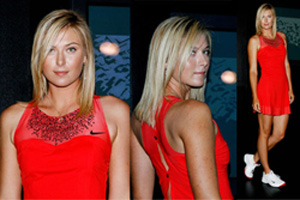The outfits that are worn by women tennis players are quite revealing and do not look like they assume any factor of being comfortable; instead, it is all part of the show that people come to look at while they play. People go to watch men play, but when it comes to watching a women's match, it can be seen as part spectacle. "The idea of sex role self-concept is important because people process information on lines of gender schema" (Prakash and Flores 235). From social practices, Nike is fulfilling the standard that women are often times objectified at the discretion of men. With the images on ads that Nike chooses to display we are seeing just that in which women are taking part in a sport role, but their real role is to sell the product and provide an object for men to stare at. In their advertisements for men Nike, has chosen to show the men simply playing tennis while the women are posed in particular ways to show off their womanly assets in interest to catching the viewer, or men's attention.
 |
In the ad on the left, Maria Sharapova is in a white tank top and skirt, which signifies that she is on the tennis court and has just hit a shot. Her leg flying up in the air could mean something sexual or is the reaction from her serving motion. The anchorage, "NO to safe second serves. Here I am" is relaying to spectators that she does not play it safe, but likes to take risks. "Here I am" is a campaign of Nike's that is a targeted effort to strengthen their brand among women. By choosing this photo, people can wonder if they really are strengthening their brand with women or just making it more accessible to men. This campaign may not necessarily help other girls or women fall in love with the idea of competing in sports, but turns to men and asks them to fall in love with women's sports. The outfits and body posture are posed as inviting ways for men to look even more than they might have before. |
| The image on the right is showing Sharapova outside of the tennis court, but still in a Nike dress that has an athletic look to it. The purpose of this ad or picture is not clearly known or stated, but we can assume it is only for men to participate in scopophilia. She is all dolled up and looks different from the previous image where she is actually participating in athletic activities. "The most frequently debated and researched topics concern the use of women in advertising in limited role portrayals relating to other people and products. The issue that is raised is whether advertising accurately reflects contemporary women's roles or stresses stereotypic roles for women through overt portrayals in particular role situations or through innuendo" (Kerin, Lundstrom, and Sciglimpaglia 38). The outfits worn by women tennis players play a part in the stereotypical way for women to dress because it is assumed that they should be in dresses or skirts, a feminine look. We can infer that the target audience for this image and ad would be men who want to look at Sharapova off the court. It could also be targeted at women because not only is Sharapova successful on the court, but she is able to obtain fame off which helps create her celebrity and fame status. |  |
 |
Another well-known women's tennis player that Nike features in their advertisements is Serena Williams. Her ad, "Meet the Queen of Heart" is a typical portrayal of a woman. In the men's Nike ads it showed them as being rough and tough through their play, but were never referred to as a king. A king is a representation of social power and the queen is under him, yet again putting men above women. In Deborah Tannen's Gender Discourse, she argues "that her cultural approach to gender differences does not deny that men dominate women in society, nor does it ascribe gender differences to women's 'essential nature'" (Tannen 4). This quote plays on the gender discourse we see in our society, but is clearly evident in sports advertising. The gender discourses are ways for society to set expectations for people's lives without giving thought on how it might impact certain people, especially women. Williams is smiling and does not look anything close to intimidating, but instead more like a queen. Her jewelry is a little excessive and I find that it would be distracting while playing, another signifier that aids in us seeing the gender identity difference. We are not able to know if she is even playing let alone on a tennis court when she is featured in this ad. It is more consumed with her appearance and how she can be used as a spectacle to not only sell more for Nike, but the tennis world as well. Both William's and Sharapova's ads show us that Nike finds it the most effective to display women in advertisements as sexy and just kind of there with no fuel behind their fire and drive that makes them so successful on the tennis court. |